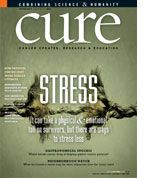Publication
Article
CURE
Bad Neighbors
Author(s):
A tumor's surroundings may reveal the answers to how cancer grows and spreads.
Stephen Paget had a question: When cancer breaks free and starts to spread, where does it go and how does it get there? As a surgeon at the West London hospital, he knew most people didn’t die from their original tumors, but from metastatic outposts in other parts of the body.
Paget’s numbers revealed a different story. After examining the records of 735 women who had died from breast cancer, he found that metastases occurred in the liver far more than any other organ. It wasn’t because of unlucky blood flow—the spleen, with similar circulation, rarely had malignancies. In the journal The Lancet, he proposed that cancer cells were like seeds, each one capable of sprouting: “When a plant goes to seed, its seeds are carried in all directions,” he wrote. “But they can only live and grow if they fall on congenial soil.”
That was March 23, 1889. Revolutionary as Paget’s idea was, it remained in the shadows of cancer research for more than another century, as scientists concentrated their investigations on the rogue properties of tumors themselves. Finally, in 2006, 80 years after Paget’s death, the journal Nature Reviews Cancer recognized his “seed and soil” hypothesis as a milestone in our understanding of cancer.
To cancer, environment matters. Tumors aren’t just self-contained bursts of growth, but living, dynamic entities that alter—and are altered by—the location they find themselves in. When women examine their breasts for cancer, they look for lumps. So what’s a lump, exactly? “What you’re feeling for is the collagen, the extracellular matrix around the tumor,” says Zena Werb, PhD, professor of anatomy at the University of California, San Francisco. The tumor itself isn’t hard. “You’re feeling for something that responds to the tumor.”
In fact, cancer is so intertwined with its surroundings, research suggests that the nonmalignant tissue nestled around a tumor can, by itself, determine whether cancer lives, dies, or simply freezes in place.
Although Paget recognized the importance of the tumor environment 120 years ago, only relatively recently have scientists begun to understand the interplay between malignant and nonmalignant cells. Eventually, research may open new avenues for therapy. While traditional cancer therapy targets the cancer itself, future strategies might not just try to disable the tumors, but change the surrounding tissue to make it less accommodating. Studies might also lead to new means of cancer prevention by revealing genes or lifestyle choices that create a cancer-friendly environment. If you can’t remove the seed, reduce the soil to dust.
“You can buy the best tomato seeds in any nursery. If you put them in sand, you don’t get tomatoes. If you don’t fertilize them, you don’t get tomatoes,” says Isaiah J. Fidler, DVM, PhD, director of the Cancer Metastasis Research Center at M.D. Anderson Cancer Center in Houston. Back in 1980, Fidler performed a 20th-century version of Paget’s experiment, injecting melanoma cells into kidney, ovary, and lung tissue that had been grafted into mice. The cancer cells came from the same source, but grew only in the ovary and lung tissue, not the kidney. For cancer, he says, “You need the right seed in the right soil.”
A hospitable environment—researchers use the term “microenvironment”—appears to be necessary not only for metastases, but for the tumors they came from. Experiments going back to the 1970s have demonstrated that some cancer cells, when placed in a normal microenvironment—that is, surrounded by cells that have never touched cancer—stop growing and settle down to a quiet life. Like spoiled kids, cancer-prone cells may be more likely to run wild if their home rewards bad behavior.
“Uncontrolled cell growth is not sufficient for cancer,” says Donald Ingber, MD, PhD, Judah Folkman Professor of Vascular Biology at Harvard Medical School and Children’s Hospital Boston. For a tumor to develop the muscle to thrive, invade surrounding organs, and dispatch cells to form still more cancers, “the tissue architecture has to break down.”
Ingber envisions the day when treatment targets the microenvironment. “You would not be trying to kill the cancer,” he says. “You would be trying to revert it to normal tissue.”
To do that, though, researchers have to understand the difference between a normal environment and that of a tumor. This is not as simple as it may sound. The tumor microenvironment is so complex that entire textbooks are devoted to it. One major distinction is the thicket of blood vessels that supply the tumor with nutrients and oxygen.
Research into this aspect of the microenvironment has already led to drugs like Avastin (bevacizumab)—approved for metastatic breast, colon, and kidney cancers as well as non-small cell lung cancer and a type of brain tumor called glioblastoma multiforme—which work to strangle the tumor’s blood supply.
But what makes some environments more susceptible to corruption by cancer cells? No one yet knows for sure. Some differences may lie in the genes a person is born with.
“We all know that there are families in which diseases run,” says Kent Hunter, PhD, head of the Metastasis Susceptibility Section at the National Cancer Institute in Bethesda, Maryland. The thinking has often been that certain people may be more prone to tumor formation, but perhaps it’s the other way around: their bodies are more receptive to nurturing the first buds of cancer. Hunter and his colleagues have performed experiments in mice suggesting that cancer is more likely to spread depending on the genetic background of the mouse, not the tumor. Or, as his NCI colleague Chand Khanna, DVM, PhD, puts it, “The soil is cultivated by a seed that hasn’t even gotten there.”
Hunter and others are now trying to tease out which particular genes till the soil. If those genes can be found, he envisions a day when doctors might test newly diagnosed patients and know which ones are more susceptible to metastasis. “It may be possible to find non-toxic compounds so we could put those patients on a preventative,” he says.
And it may be possible to reverse some of the changes triggered by metastatic cells. Experiments suggest that metastatic cells are able to grow uncontrollably, partly because they turn on genes used in the womb—genes that in this case promote the growth of the tumor as they would an embryo, says Mary Hendrix, PhD, head of the Children’s Memorial Research Center at Northwestern University’s Feinberg School of Medicine in Chicago. She and her colleagues are hoping to test an experimental treatment soon that suppresses those embryonic genes in hopes of returning the tissue—and the cancer—into a more normal state. “Many highly metastatic cancers turn on these embryonic pathways,” she says. “It’s up to us to figure out how to target them.”
Researchers have other strategies to not only alter a tumor’s microenvironment, but to exploit it. For example, Steven Libutti, MD, director of the Montefiore-Einstein Center for Cancer Care in New York, is hoping to design a therapy that will recognize the abnormal tumor microenvironment and deliver drugs there.
“Tumor vessels growing in the microenvironment of the cancer look very different than vessels growing in normal tissues,” he says. He and his colleagues are working to develop a Trojan horse—a modified virus—that would seek the vessels of the tumor and deliver a drug to destroy the cancer.
This year, in the journal PLoS ONE, he described tests of the drug in 24 pet dogs with cancer who received various doses of the drug; 14 got the full amount. In eight of the 14 dogs, tumors either stabilized or shrank, and the dogs did not appear to experience any effects of toxicity. The results are encouraging enough that the scientists are seeking approval to begin tests of the approach in people. “We’re leveraging the fact that the tumor environment makes it different from normal tissue,” Libutti says.
Insights into the microenvironment also help explain why surgery, which remains the most effective treatment for tumors, doesn’t always work. Removing the tumor doesn’t always affect the surrounding environment, and it may be necessary to change both.
“I look at it as extremely exciting,” Libutti says. “We’ve spent the better part of a century studying tumors and focusing most of our interventions on the cancer cells. But for most solid tumors, we’ve yet to develop a therapy that’s focused on the cancer cells that results in cure.” Cancer, he says, is a part of its environment, and each is dependent on the other. “It’s one big entity. I think that by studying the other cellular players, we may be able to develop therapies that will attack the whole tumor.”
View Illustration: Supporting Cast
While traditional cancer therapy targets the cancer itself, future strategies might not just try to disable the tumors, but change the surrounding tissue to make it less accommodating.
Randal Ratliff of Burns, Tennessee, began receiving Avastin two years ago, when doctors discovered that colon cancer had spread to his lungs and liver. Doctors at Vanderbilt University Medical Center in Nashville prescribed the drug for the 63-year-old retiree (along with other chemotherapy) because his tumors were numerous and small, he says. Scans so far show that the spots in his lungs are shrinking. “That’s all I can hope for at this point,” he says. “I’m very thankful. I still feel good.”
Other drugs like Revlimid (lenalidomide) for multiple myeloma and myelodysplastic syndromes, Sutent (sunitinib) for kidney cancer and gastrointestinal stromal tumor, and ­Nexavar (sorafenib) for liver and kidney cancers also work to interfere with a cancer’s blood supply. Yet tumors do much morethan just coax blood vessels to grow. They also produce enzymes that digest the extracellular matrix holding tissues together, and put physical pressure on these scaffolds. This distorts the entire structure and deforms the attached cells. Ingber compares it to a run in a nylon stocking, becoming thinner and stretched.
When tumors deform the normal matrix of cells, the change in mechanics causes the cells to increase production of chemicals that encourage blood vessels to grow in leaky tangles. “Changes in the matrix can actually drive both blood vessel growth and tumor formation,” Ingber says.
According to one way of thinking, these and other tumor dynamics cause the body to respond to cancer as if it were an unhealed wound. A cut heals because certain cells rush to the site and release chemicals that promote cell division. You want this to happen—cell division is necessary to form new blood vessels and skin. In the case of cancer, malignant cells exploit the system to their own advantage. A chemical released after cells are wounded, called transforming growth factor beta, is critical to the growth of a tumor. Inhibition of this chemical has become a key target for developing new cancer therapy, with drugs working their way through clinical trials.
“When you have a normal situation like a wound healing, you want to have the wound heal and then be finished,” Werb says. “In the case of a tumor, there’s no end.”
Hunter envisions a day when doctors might test patients with newly diagnosed cancer and know which ones are more susceptible to metastasis.
At the time, doctors believed that metastases developed randomly—that malignant cells were swept through the bloodstream and grew in spots where they happened to lodge. A tumor’s location, according to this way of thinking, was largely a function of chance.






